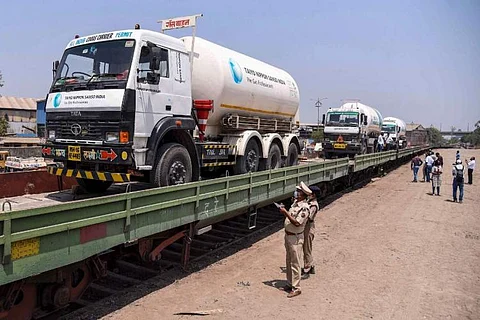

Andhra Pradesh has been asking the Union government to allot the state 1000 MT of oxygen. Presently, the Union government has allocated the state 590MT of oxygen daily. While only around 550MT of oxygen is being used due to various limitations, the state is expecting the demand to soar and hence has been pressing for more allocation of oxygen. Meanwhile, the state is making efforts to ensure a more permanent solution to the crisis.
Andhra Pradesh has been grappling with the second wave of COVID-19, as daily cases hover around the 20,000-mark. During the course of the past two days, nearly 190 persons have succumbed to the pandemic.
The state has ordered the release of Rs 310 crore for improving the oxygen infrastructure. The money released will be used for not only setting up oxygen-producing plants but also to improve the supply infrastructure in the state. According to the government order, the funds will be utilised to set up oxygen plants at 49 locations across the state, purchase of 50 cryogenic oxygen tankers, and also for setting up 10,000 additional oxygen lines in the state. Towards maintenance of the oxygen plants, the department has allocated a sum of Rs 60 lakh per month, to each district, for the next six months.
Meanwhile, the National Highways Authorities of India has decided to help the state with 42 oxygen plants. According to Health Commissioner Katamaneni Bhasker, the NHAI is executing the works at three sites presently and the work at the fourth is expected to start soon. While a 500 LPM plant is coming up at East Godavari district’s Amalapauram and Chittoor district’s Madanapalli, a 1000 LPM plant is coming up in West Godavari’s Tadepalligudem and Anantapur’s Hindupur. The vendors for the 38 sites have been finalised but the work will start only after the NHAI headquarters gives a green signal.
The Andhra Pradesh government has opened a State Oxygen War Room (SOWR) to ensure seamless management of oxygen supply to all districts and thereafter to hospitals for treatment of critical Covid-19 patients.
A District Oxygen War Room has also been established in each of the 13 districts for the purpose.
“lt is extremely important to ensure seamless management of oxygen supply to the state, from state to the districts and from districts to hospitals and refillers and from refillers to the hospitals, which are the consuming points without any chain break on day to day and hourly basis," Principal Secretary (Health) Anil Kumar Singhal said in an order.
The war rooms would have nodal officers from industries, revenue, disaster management, police, transport, health and Information Technology departments.
The State Oxygen War Room would be responsible for monitoring the production, storage, transport, distribution, consumption and supply chain monitoring of medical oxygen at the state level, he noted.
The Industries Department would coordinate the overall production and supply of Liquid Medical Oxygen from the source points.
The Transport Department has been entrusted with the responsibility to include as many cryogenic vehicles as possible into the fleet operating in AP's oxygen supply chain.
Singhal asked the police department to ensure unrestricted movement of vehicles carrying liquid medical oxygen within and outside the state, by creating a green channel.
On oxygen management at the hospital level, Singhal said the number of beds should be increased only upon assessing the oxygen supplies, after informing the State Oxygen War Room about any increase.
"Every hospital would be required to maintain the consumption below 20 litres per minute. Any hospital exceeding this average is to be understood as mismanaged," the Principal Secretary cautioned.
(With agency inputs)